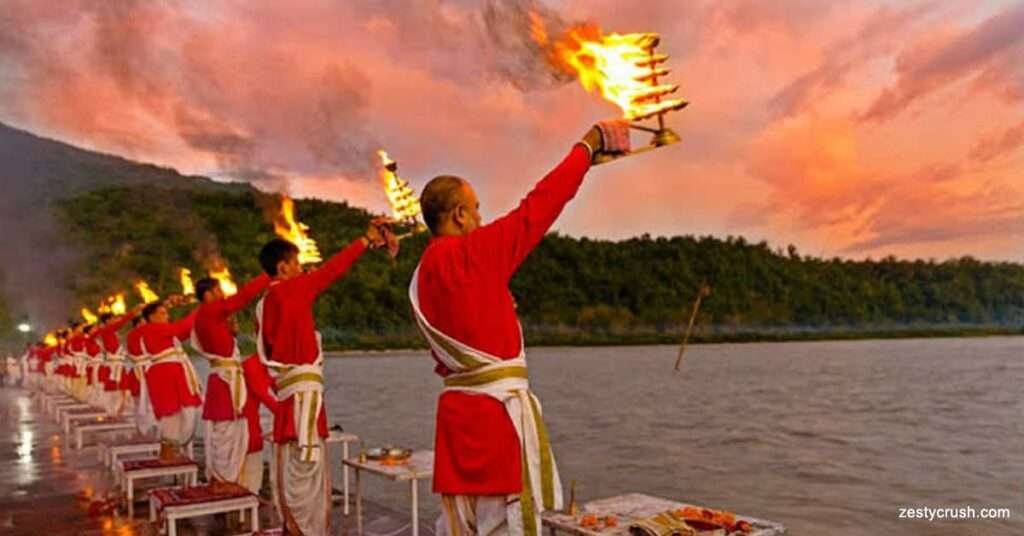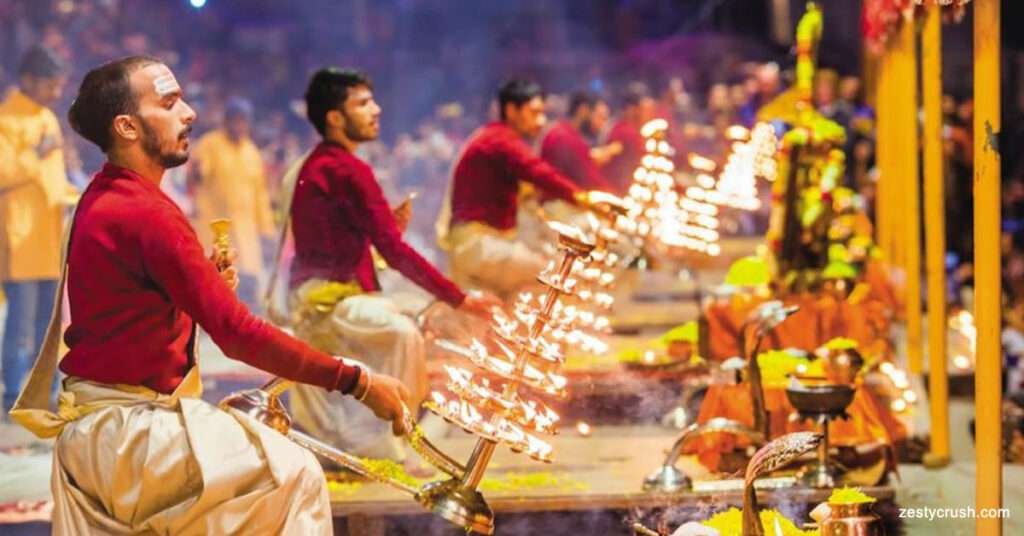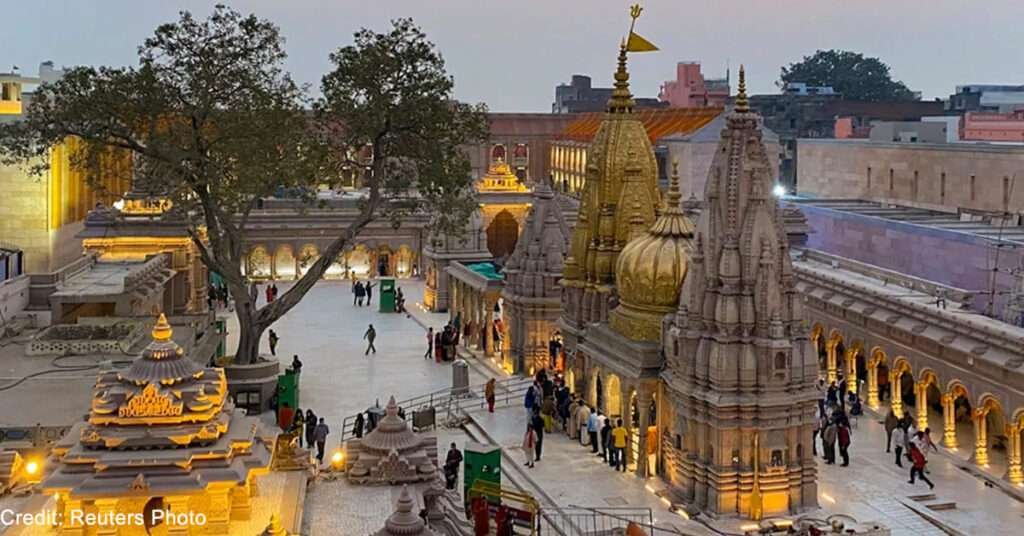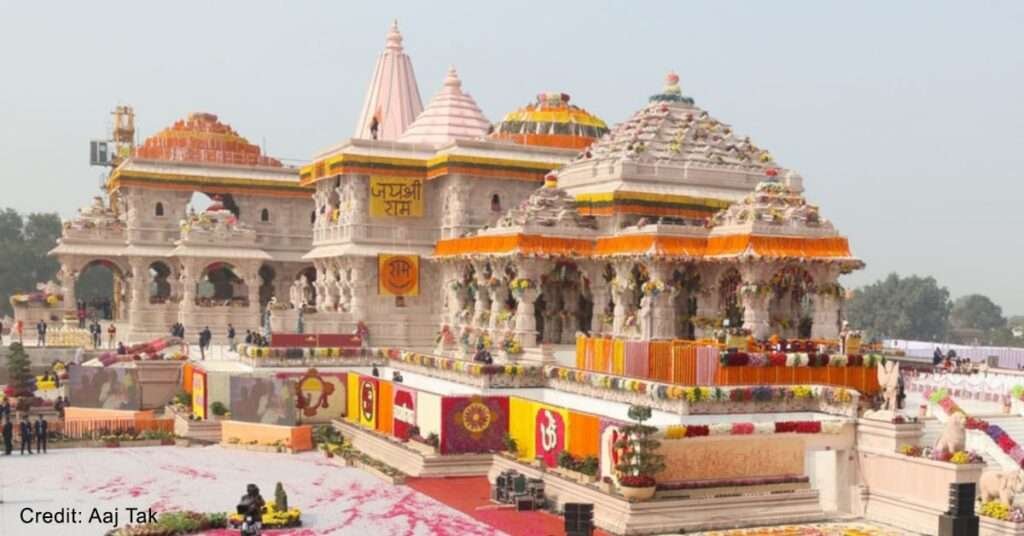Leh Ladakh Monastery Guide: Must-Visit Sacred Sites
Ladakh, with its grand mountains and deep history of spiritualism, houses some of the most breathtaking Buddhist monasteries in the world, known as gompas. From the stunning Diskit Monastery Ladakh to the quiet beauty of Shey Monastery, each Ladakh monastery offers a unique experience. Whether you are a history buff, spiritual seeker, or adventure lover, Ladakh’s Buddhist monasteries promise to enchant and inspire.
Here’s a guide to 15 famous monasteries in Ladakh, with a brief history, key attractions, visiting times, and entry fees.
1. Hemis Monastery (40 km Southeast of Leh)
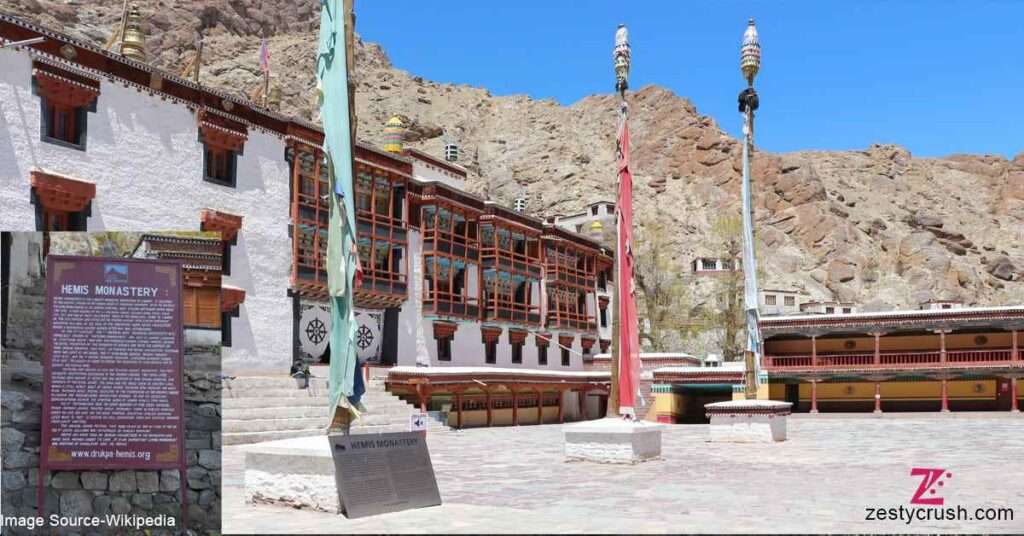
Founded by King Sengge Namgyal in the 17th century, one of the biggest and richest monasteries in Ladakh, its importance arises from its association with the Drukpa Lineage of Tibetan Buddhism.
This vast monastery lies hidden in the peaceful hills and has gained reputation for hosting its annual Hemis Festival, which commemorates the birth of Guru Padmasambhava. It accommodates a large collection of old relics, including some very rare thangkas and statues, not to mention the great Buddha temple in Ladakh. The serenity and beauty surrounding it make it a must-visit place while crossing Ladakh.
Visiting Hours: 8:00 AM – 1:00 PM, 2:00 PM – 6:00 PM
Entry Fee: ₹100
2. Thiksey Monastery (18 km from Leh)
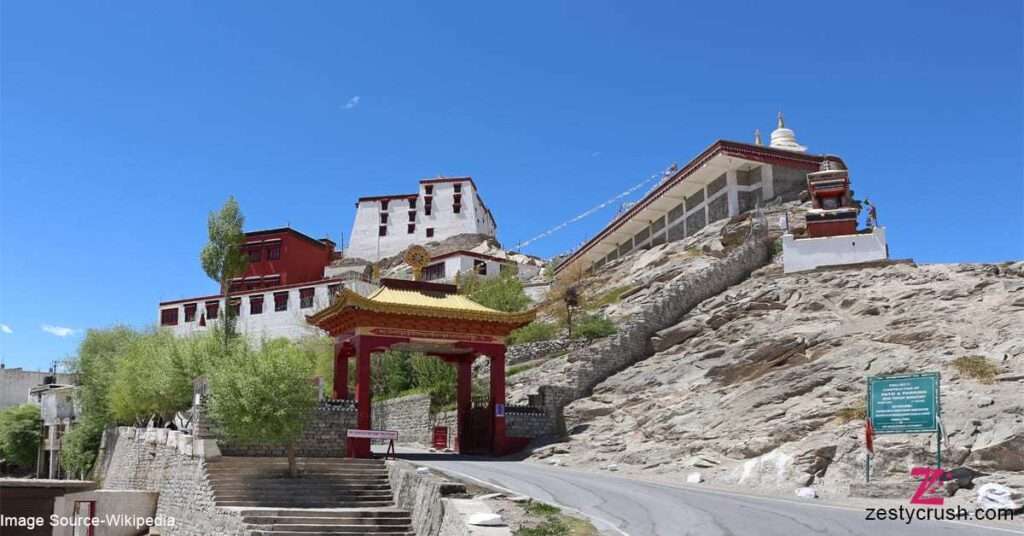
Thiksey Monastery, built in the 15th century, is one of the most visually striking monasteries in Ladakh, modeled after the Potala Palace in Tibet. It was founded by Sherab Zangpo of the Gelugpa sect, and over time, it grew into a major spiritual hub.
The stunning 12-story monastery provides incomparable views of the Indus Valley. Its main attraction is the two-story Maitreya Buddha statue. Many ancient scriptures, thangkas, and relics are kept here, and the morning prayer session held here is indeed a devout experience not to be missed.
Visiting Hours: 7:00 AM – 7:00 PM
Entry Fee: ₹30
3. Diskit Monastery (Nubra Valley, 115 km from Leh)
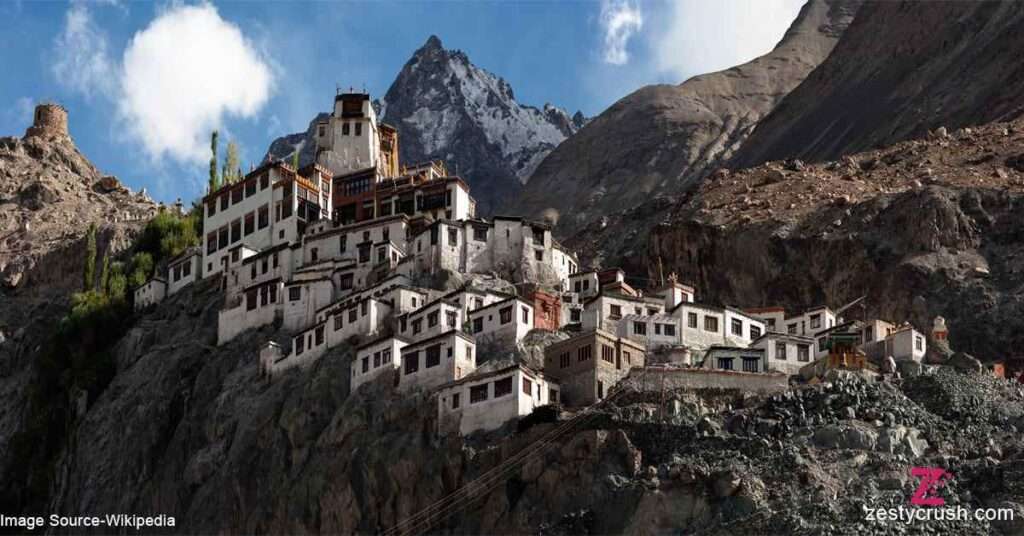
Diskit Monastery is the oldest and largest gompa in Nubra Valley, established in the 14th century by Changzem Tserab Zangpo. Its history is practically inseparable from that of the Gelugpa sect as a center for the diffusion of Buddhism in the area.
The most iconic landmark of Diskit Monastery Ladakh is the towering 32-meter statue of Maitreya Buddha that casts a long shadow over the Nubra Valley. The monastery has various prayer halls and statues and intricate murals. There simply cannot be any better panoramic view than those from atop the roof of the monastery.
Visiting Hours: 7:00 AM – 7:00 PM
Entry Fee: ₹30
4. Alchi Monastery (70 km from Leh)
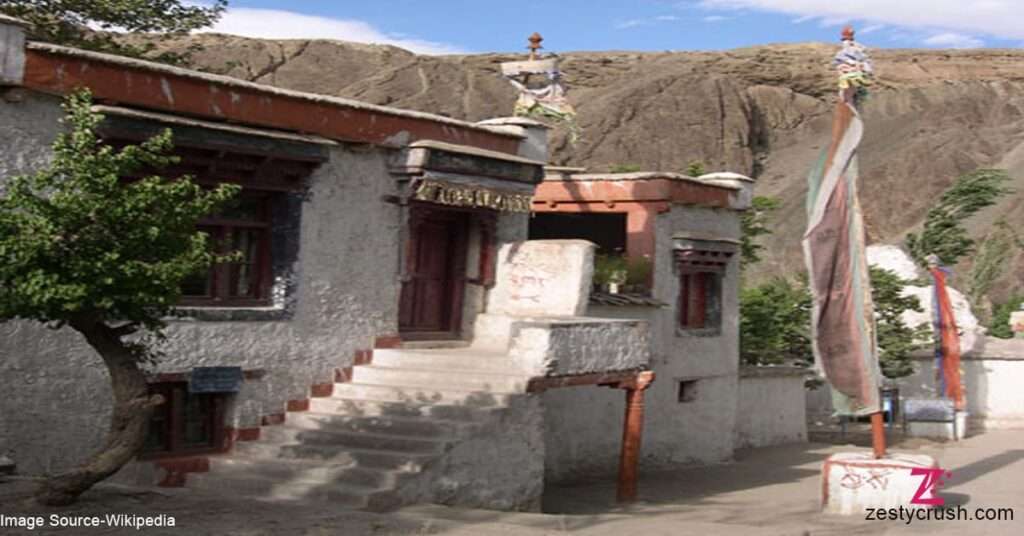
Dating back to the 10th century, Alchi Monastery is one of the oldest Buddhist monasteries in Ladakh. It was founded by the great translator Rinchen Zangpo and is famous for its Indo-Tibetan artistic fusion, with rich murals and wooden carvings.
This gompa stands out for its unique location on the flatlands near the Indus River, rather than on a hill like most monasteries. The monastery’s art, including depictions of Hindu and Buddhist deities, is considered a priceless treasure of early Tibetan Buddhism.
Visiting Hours: 8:00 AM – 6:00 PM
Entry Fee: ₹25
5. Spituk Monastery (6 km from Leh)
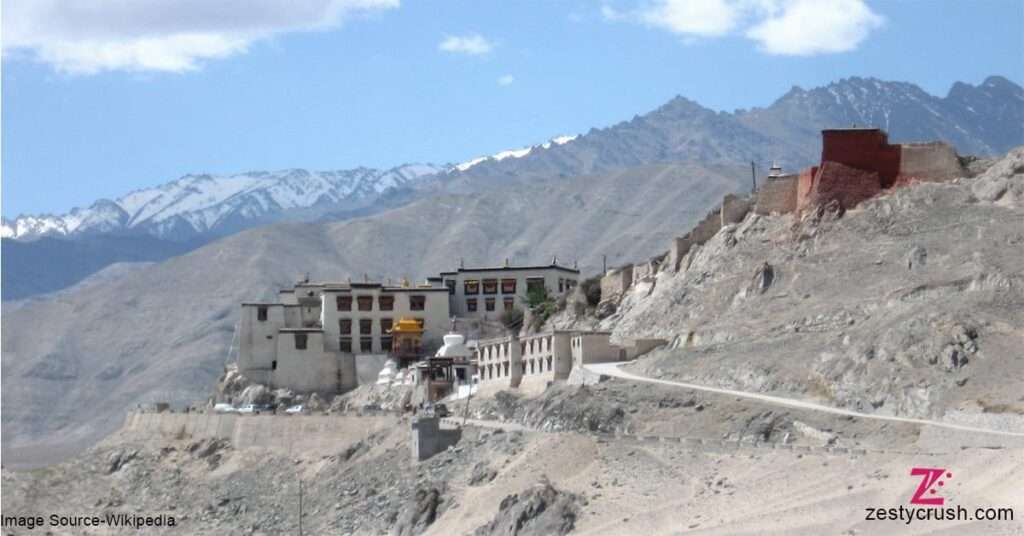
Founded in the 11th century by Od-de, Spituk Monastery was originally part of the Kadampa school but eventually evolved to the Gelugpa sect as much influence was received from Tsongkhapa. It then became an important religious site in Ladakh.
The Spituk Monastery is appreciated for panoramic views of the Indus Valley from its high hill and its unique blending of history and spirituality. The monastery houses an interesting collection of ancient masks, statues, and arms on display during the annual Gustor Festival. Quite unusual among Buddhist monasteries is the presence of a very unusual temple dedicated to Kali.
Visiting Hours: 8:00 AM – 1:00 PM, 1:30 PM – 6:00 PM
Entry Fee: ₹20
6. Lamayuru Monastery (114 km from Leh)
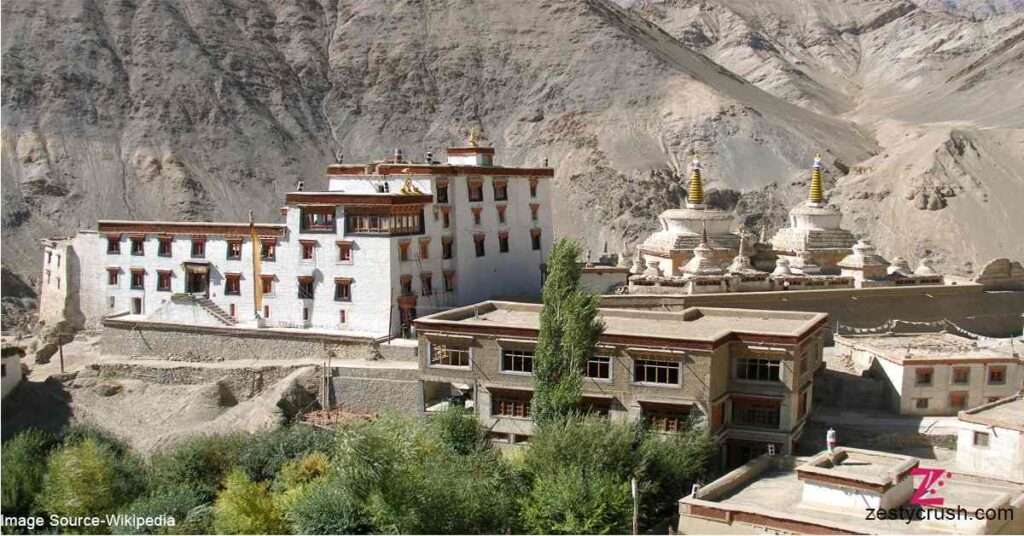
Lamayuru Monastery was founded in the 10th century by the celebrated Indian scholar Mahasiddha Naropa and remains one of the oldest monasteries in the harsh district of Ladakh. It boasts a strong lineage with the Drikung Kagyu school of Tibetan Buddhism.
Lamayuru is called the “Moonland Monastery” due to its extremely otherworldly landscape, since the name originates from its lunar-like terrain. Its visitors are always glad to see the breathtaking vistas, appraise the frescoes on the walls, and participate in the festival of Lamayuru, at which the masked monks perform dances as offerings to the deities of the village.
Visiting Hours: 6:00 AM – 6:00 PM
Entry Fee: ₹30
7. Shey Monastery (13 km from Leh)
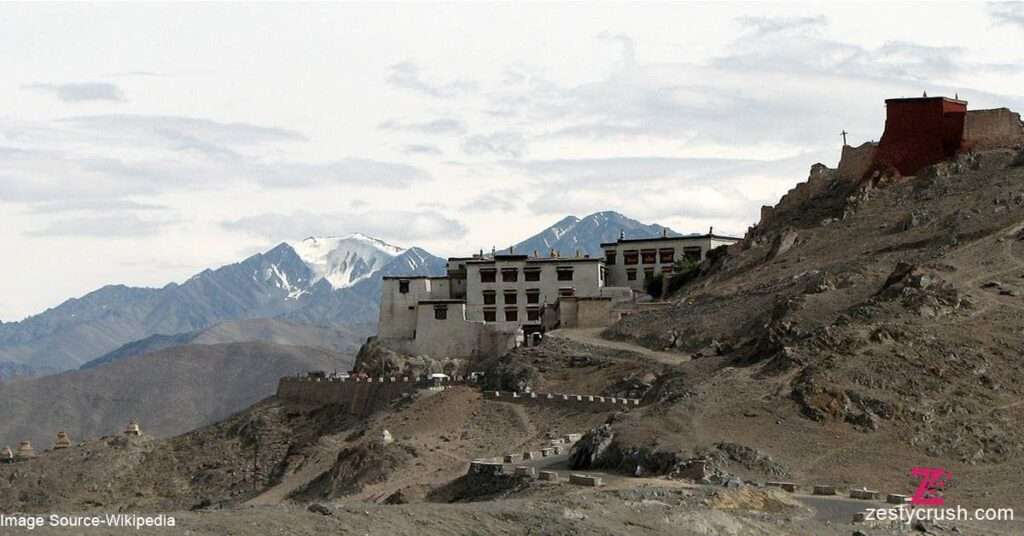
Shey Monastery was built in the 17th century by Deldan Namgyal as the summer capital of the Ladakh royal family. The monastery is most famous for its gigantic golden statue of Shakyamuni Buddha, which stands 12 meters tall, one of the biggest in Ladakh.
Shey’s serene atmosphere makes it an ideal place for people who seek serenity and an insight to the royal traditions of Ladakh. The nearby Shey Palace adds a historic dimension, while the view of the Indus Valley from the monastery is just gorgeous.
Visiting Hours: 7:00 AM – 6:00 PM
Entry Fee: ₹20
8. Likir Monastery (56 km from Leh)
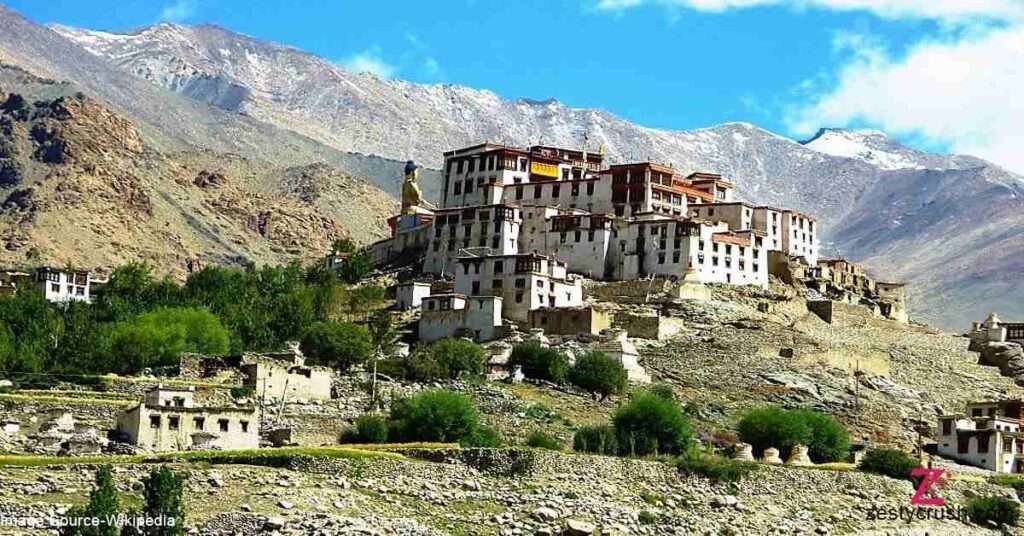
Established in the 11th century by Lama Duwang Chosje under the patronage of King Lhachen Gyalpo, Likir Monastery is one of the oldest and most well-preserved gompas in Ladakh. It belongs to the Gelugpa school of Tibetan Buddhism.
Likir is famous for its gigantic outdoor Buddha statue, which overlooks the entire valley. The monastery contains numerous ancient manuscripts and beautiful murals. The tranquil surroundings and the serene view of the Indus Valley make it a must-visit for anyone exploring Leh monasteries.
Visiting Hours: 8:00 AM – 5:00 PM
Entry Fee: ₹25
9. Phugtal Monastery (Zanskar Valley)
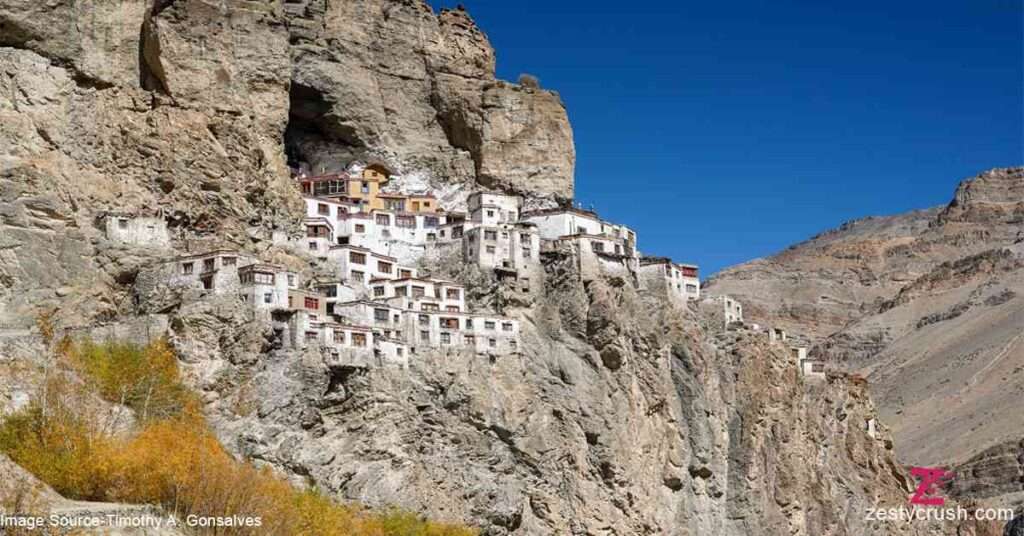
Phugtal Monastery, believed to be founded in the early 12th century by Gangsem Sherap Sampo, is a remote Buddhist monastery in Ladakh built into a cliffside in the remote Zanskar Valley. The monastery’s unique architecture, blending with the natural rock, has made it famous among adventurers.
This impressive cave gompa is accessible only by trek, making it one of the most secluded and secret monasteries in the world. The prayer halls and meditation rooms, combined with their old frescoes, form a spiritually stunning journey. And, lastly, the backdrop of such a breathtaking scenery overlooking the Lungnak River gorge is almost unbelievable.
Visiting Hours: Open all day
Entry Fee: Free
10. Stakna Monastery (22 km from Leh)
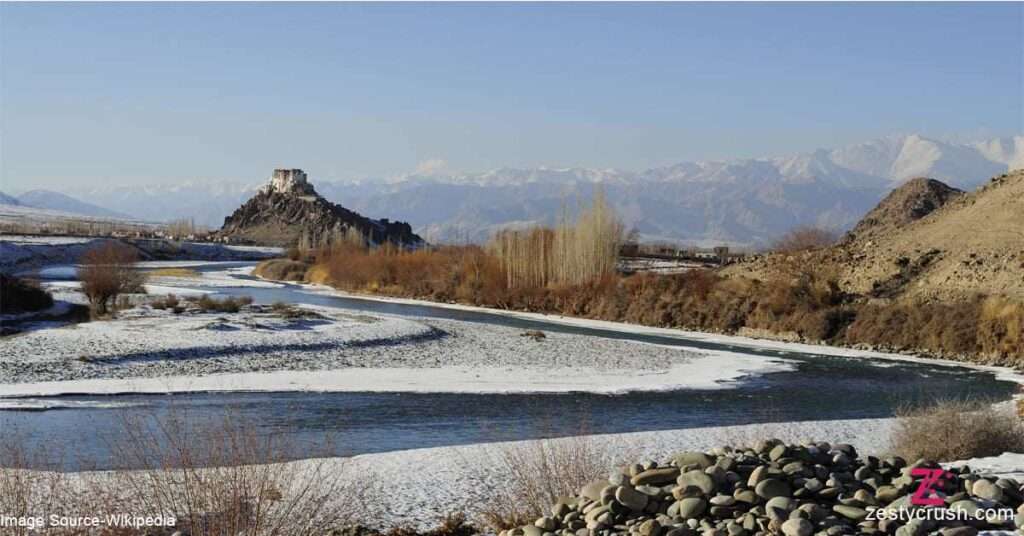
Founded in the 16th century by the Bhutanese scholar Chosje Jamyang Palkar, Stakna Monastery is perched on a hill shaped like a tiger’s nose, giving it its name. It belongs to the Drukpa sect of Tibetan Buddhism.
Stakna offers stunning views of the Indus River and the valley below. Visitors can explore its richly decorated interiors, filled with Buddhist art, statues, and scriptures. The peaceful and serene surroundings make it a perfect retreat for those looking to escape the crowds.
Visiting Hours: 7:00 AM – 6:00 PM
Entry Fee: ₹20
11. Rangdum Monastery (341 km from Leh)
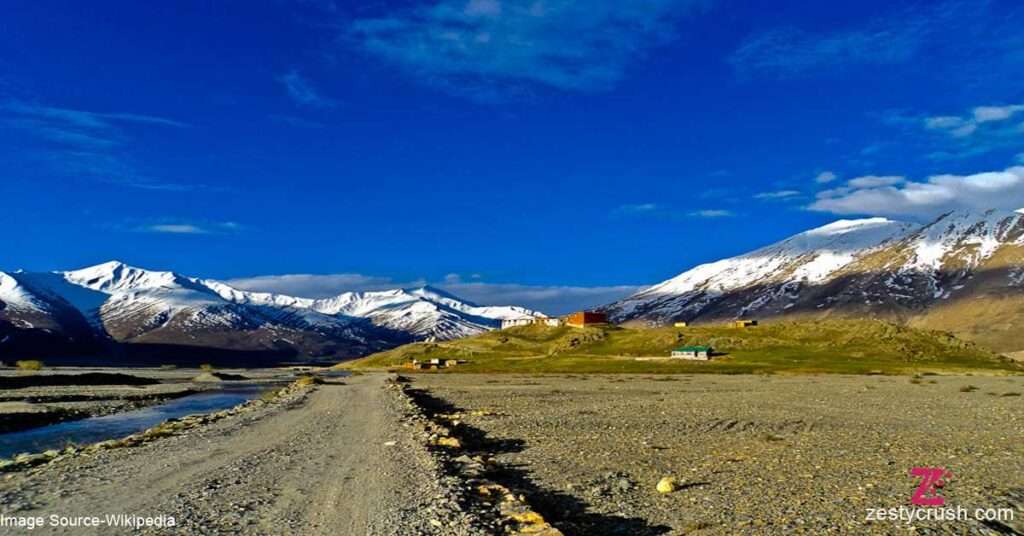
Founded in the 18th century, Rangdum Monastery is located in the remote Zanskar Valley. The monastery’s isolation has made it a place of solitude and deep spirituality, surrounded by snow-capped peaks and high-altitude plains.
The stark beauty of Rangdum and its simple yet powerful presence amidst the mountains draw visitors looking for off-the-beaten-path adventures. The scenic views of the valley and the serene silence make it one of the most peaceful monasteries in Ladakh.
Visiting Hours: Open all day
Entry Fee: Free
12. Matho Monastery (25 km from Leh)
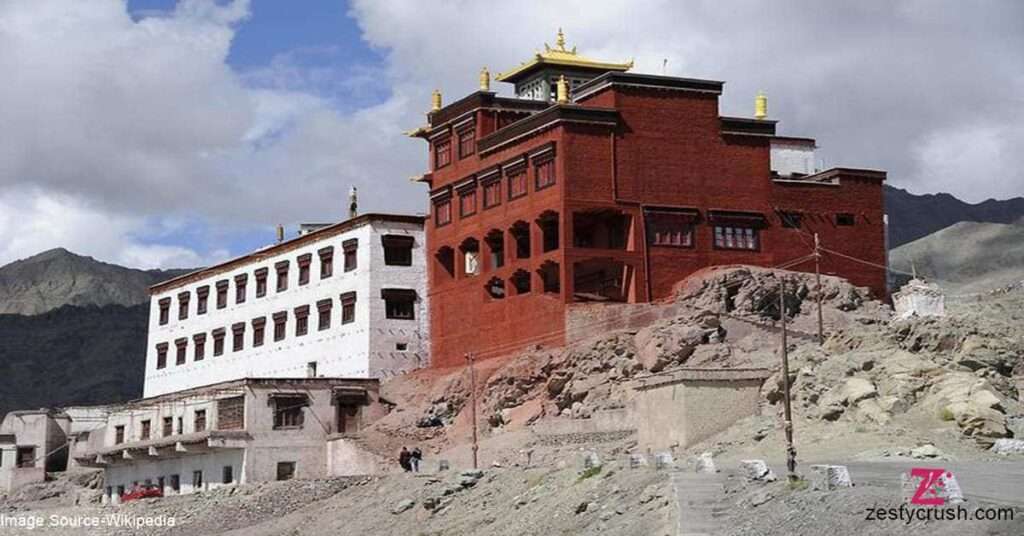
It is one of the oldest monasteries in Ladakh, located within the district of Leh. Founded by Lama Dugpa Dorje in the 16th century, it is the only Sakya sect monastery in Ladakh. The annual Oracle Festival held here is unique in Ladakh.
During the festival, the monks become oracles to perform the ancient rituals to solve the mystery of the future. Visitors are invited to watch this mystifying spectacle under breathtaking panoramic views of the valley below. In addition, Matho houses a remarkable collection of thangkas, statues, and ancient texts.
Visiting Hours: 8:00 AM – 5:00 PM
Entry Fee: ₹30
13. Takthok Monastery (48 km from Leh)
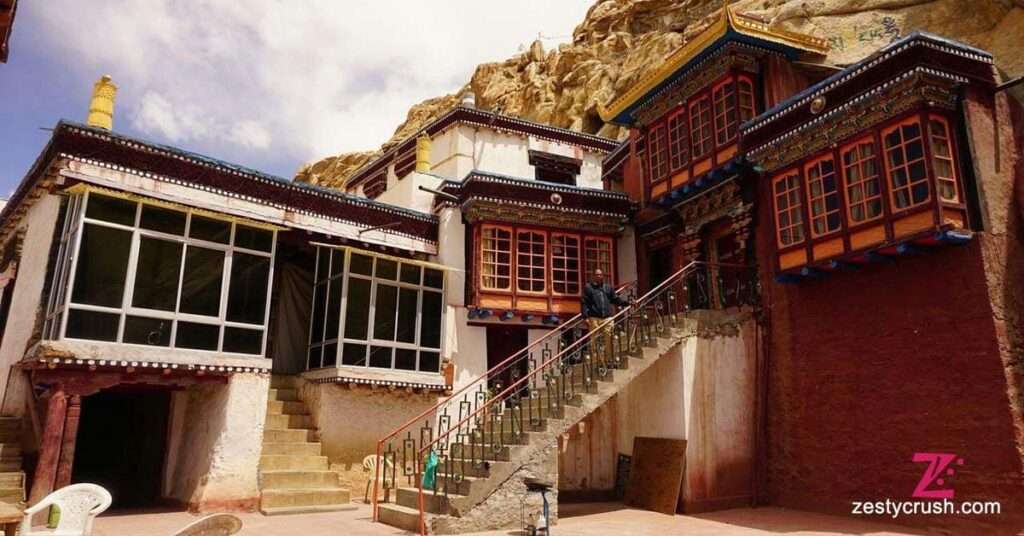
The name Takthok means “rock-roof,” and its construction nestled within a natural cave confirms the title. Takthok, founded in the 16th century, is the only Nyingma sect monastery in Ladakh, which alone can explain its unique spiritual air.
The cave represents the monastery’s prayer hall, replete with mystical energies that capture both pilgrims and tourists. Takthok Monastery is a wonderful combination of nature and spirituality- murals, statues and ancient scriptures sit wrapped in the ancient walls of a cave.
Visiting Hours: 6:00 AM – 1:00 PM, 1:30 PM – 7:00 PM
Entry Fee: ₹20
14. Sankar Monastery (4 km from Leh)
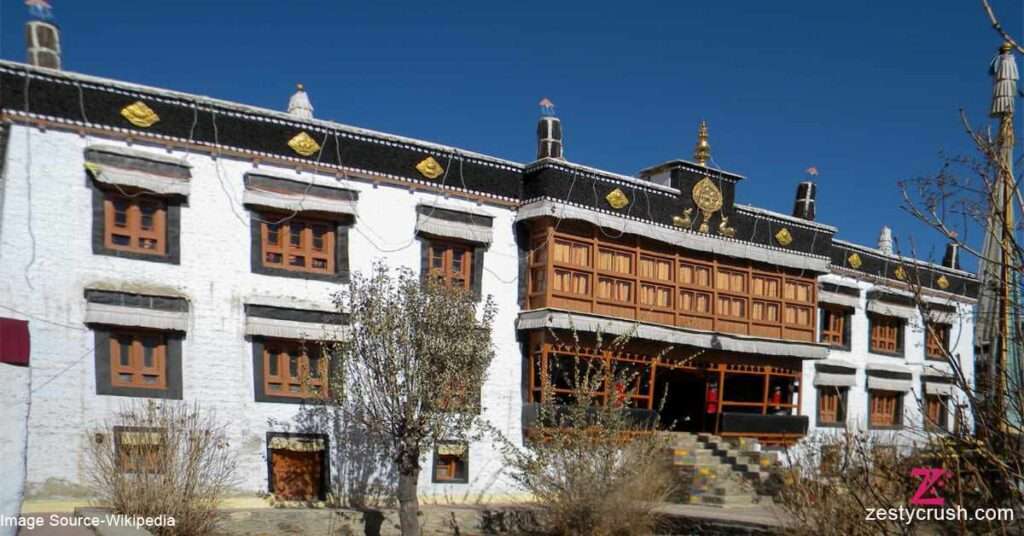
Sankar Monastery, just a short walk from Leh, is a small but peaceful monastery associated with the Gelugpa school. It serves as the residence of the head of the Gelugpa sect in Ladakh.
Though small in size, Sankar’s intimate setting offers visitors a quiet space for reflection. It is ideal for a peaceful morning or evening stroll from Leh, and the path leading to the monastery is scenic, making it an easy and enjoyable visit.
Visiting Hours: 7:00 AM – 10:00 AM, 5:00 PM – 7:00 PM
Entry Fee: Free
15. Phyang Monastery (19 km from Leh)
Built in the 16th century by King Tashi Namgyal, Phyang Monastery is a center of Buddhist learning and culture. The monastery belongs to the Drikung Kagyu school and is known for its vast collection of artifacts, including ancient thangkas and manuscripts.
The annual Phyang Tsedup Festival, held in July or August, is a vibrant display of sacred dances and rituals. The monastery’s position atop a hill provides panoramic views of the valley, making it a peaceful and scenic destination.
Visiting Hours: 7:00 AM – 6:00 PM
Entry Fee: ₹30
Conclusion
Exploring Ladakh’s monasteries is a journey through history, spirituality, and the breathtaking landscapes of the Himalayas. Each Leh monastery offers something unique, from the ancient frescoes of Alchi to the cliffside wonder of Phugtal. These Buddhist monasteries in Ladakh are more than just places of worship—they are living museums of art, culture, and tradition. Visit between May and September for the best experience, and be sure to attend the festivals for a deeper connection with the local culture.
FAQ
What is the best time to visit Ladakh monasteries?
The best time to visit Ladakh monasteries is from May to September, when the weather is ideal for travel.
Do I need a permit to visit Ladakh monasteries?
Yes, an Inner Line Permit is required for certain areas like Nubra Valley and Zanskar Valley.
Which is the oldest monastery in Ladakh?
Alchi Monastery, founded in the 10th century, is the oldest monastery in Ladakh.
Can I take photographs inside the monasteries?
Photography is generally allowed outside, but in most Buddhist monasteries, it’s restricted inside the prayer halls.
How do I reach Phugtal Monastery?
Phugtal Monastery is accessible only via trekking from Padum in Zanskar Valley.
Which monastery hosts the Hemis Festival?
The Hemis Festival takes place at Hemis Monastery every year.
What should I wear when visiting monasteries?
It’s recommended to wear modest clothing, covering shoulders and knees, out of respect for local customs.

